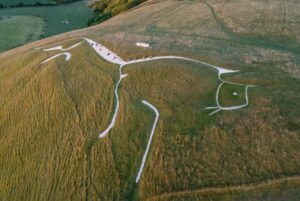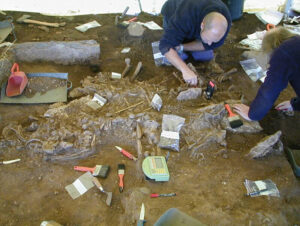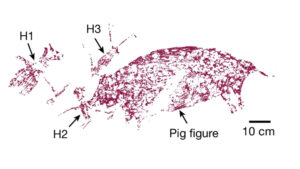Archaeologists stationed at a dig site in North Dakota have just unearthed an extremely well-preserved thescelosaurus leg.
And we do mean well-preserved. The bone has some skin attached, plus remnants of the debris that rained down on earth immediately after the asteroid that killed off the dinosaurs hit 66 million years ago.
What’s the big deal? Scientists are suddenly zeroing in on the date the asteroid that killed the dinosaurs hit the earth. The thescelosaurus, which Sir David Attenborough called “impossible,” could be an integral clue.
A mounting body of evidence shows that the small herbivorous dinosaur died immediately after the asteroid hit. Phillip Manning, a natural history professor at the University of Manchester, was involved in the discovery at the well-known dig site called Tanis.
“It’s absolutely bonkers,” he told the BBC. He added that the leg amounts to the “ultimate dinosaur drumstick”.

The dinosaur drumstick in question. Photo: Tanis dig team via Twitter
‘Gobsmacking’ debris shows time of death
The Chicxulub asteroid that triggered the global extinction struck some 3,000km south of the Tanis dig site in the Yucatan peninsula. At Tanis, scientists found not only the thescelosaur’s leg but other intriguing fossils and debris.
These treasures included the remains of fish that had inhaled impact debris and a turtle skewered with a wooden stick. It also had fossils of small mammals, skin from a triceratops, a pterosaur embryo inside its egg, and what would be the piece de resistance if not for the drumstick: a possible fragment of the asteroid itself. All added to the mounting evidence that these creatures were alive the day that the asteroid struck.

Some specific debris that only came down immediately after the strike makes for more accurate dating than traditional carbon dating.
“The time resolution we can achieve at this site is beyond our wildest dreams,” enthused Manning. “It’s absolutely, gobsmackingly beautiful. I never dreamed in all my career that I would get to look at something…so beautiful, and also tells such a wonderful story.”

The impact flung up distinctive debris, including glass pellets from molten rock, found at the site in the gills of fossil fish. Illustration: Shutterstock
‘Impossible fossil,’ says Attenborough
For the past three years, a film crew led by Sir David Attenborough has documented the Tanis dig and its findings. “When Sir David looked at [the leg], he smiled and said ‘That is an impossible fossil’. And I agreed,” said Manning.
“We’ve got so many details with this site that tell us what happened moment by moment, it’s almost like watching it play out in the movies,” said Robert DePalma, a graduate student who is leading the dig. “You look at the rock column, you look at the fossils there, and it brings you back to that day.
Dinosaurs: The Final Day with Sir David Attenborough premieres on April 15 on the BBC.






